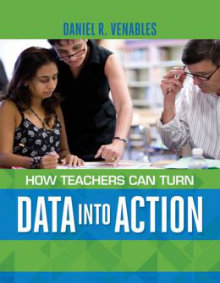A Thorough Guide to Turning Data into Action
How Teachers Can Turn Data into Action
By Daniel R. Venables
(ASCD, 2014 – Learn more)
Reviewed by Dina Murphy
I have been hearing about “data-driven instruction” for some time now – since well before my recent re-entry into the classroom. My husband is also an educator, so “data” had flavored a fair number of conversations about his work experiences prior to my reincarnation as a seventh grade math teacher.
Buzzwords like data-driven instruction arise frequently in education. They may represent important ideas but too often they quickly lose their impact when educators, both instructional and administrative, throw the terms around, evincing authority but failing to demonstrate much understanding of the conceptual thinking underlying the buzzwords.

I chose to read and review How Teachers Can Turn Data into Action by Daniel Venables in the hope that it would help bridge the gap between the data talks we have and the actions we teachers need to take as a result of those meetings. Conclusion: this book will most definitely help me — and potentially my team teachers — to do just that.
Starting with the why, getting to the how
When I first picked up Data into Action, I made the mistake of reading everything, start to finish. And I didn’t just begin at Chapter One, I read the acknowledgements, the preface, and the introduction before ever even getting to the “action.”
As a result, I initially became very bored: Daniel Venables was preaching to the choir. I didn’t want to hear why teachers should turn data into action, or why they should form and work with professional learning communities (referred to as PLCs throughout the book). I wanted to know, very specifically, how to turn data into action.
Even the first chapter, which effectively discusses the relevance of data literacy, doesn’t quite jump into the fray. If you are an educator who is already sold on the importance of data driven instruction, I would advise skipping to the chase, and beginning with the chapter titled Data Meeting 1. Here we get to the meat of the matter and are rewarded with excellent practice, protocols, and advice. (If you’re not quite convinced, then by all means read Venables’ convincing case for letting data help shape instruction.)
Recognizing and overcoming the challenges
From this point on, we are given some excellent formulaic direction for using data talks in districts or schools. We are taken through a process that begins with the type of data to be analyzed: is it after the fact, which allows us to address instruction; is it pre-test, which is forward-looking, and therefore diagnostic; or is it an early mid-year benchmark, that allows for learning and instructional gaps to be identified and addressed.
The book then proceeds through steps that will ideally allow the members of the team to not only deal with learning and instructional gaps, but better distinguish between the two. Probable pitfalls, omissions and errors are likewise addressed. One excellent point that is made is for teachers (and all educators) to not get bogged down by things over which they have no control or influence.
There are many obstacles that teachers will encounter in the classroom: some we can do something about, but many of the most troublesome are things over which we have no control. Mr. Venables draws attention to the danger of obsessing on this, since “it can… lead teacher teams down a path of helplessness and squandered time.” (p. 49)
Since the goal of the team (department, school, district… ) is the overall success of the students, we owe it to them to get over ourselves and figure out how we can best reach that goal. Venables’ process is designed to help us get there. It is offered to the reader as a series of five data meetings, each with very particular goals/steps. Certain situations allow for a greater or lesser number of meetings, and these are described in great detail.
When it comes time to formulate a Data Action Plan, the author once again offers specific guidelines to help ensure creating an effective plan. SMART (specific, measurable, attainable, relevant and time-bound) goals do, in fact, bear considerable resemblance to campus and district improvement plans, in that they meet all these attributes. The upshot of this is that they become very reachable, which is what everyone wants.
All the specifics and a packed appendix, too
This is an excellent guide to planning, ordering, and running data talks, and is well worth the read. To top it off, deconstructed protocols, flowcharts and checklists are included in the appendix, for use as resources when instituting this Data Action Model.
If yours is a school or district that is interested in using data talks to improve instruction, or has made the attempt with limited effectiveness, I strongly recommend that you consider the methods described in How Teachers Can Turn Data into Action as a way to improve the use of data with your teams.
Dina Murphy teaches seventh grade Math at West Brazos Junior High in Brazoria, Texas. Despite having planned to teach Social Studies, she enjoys the challenges of helping students learn to share her love of math. Dina and her 7th grade math team partner are happily embracing technology in their classrooms, and have set themselves a high learning curve in order to offer their students a strong math curriculum that also gives them a good base in 21st century communication and work technology.




























